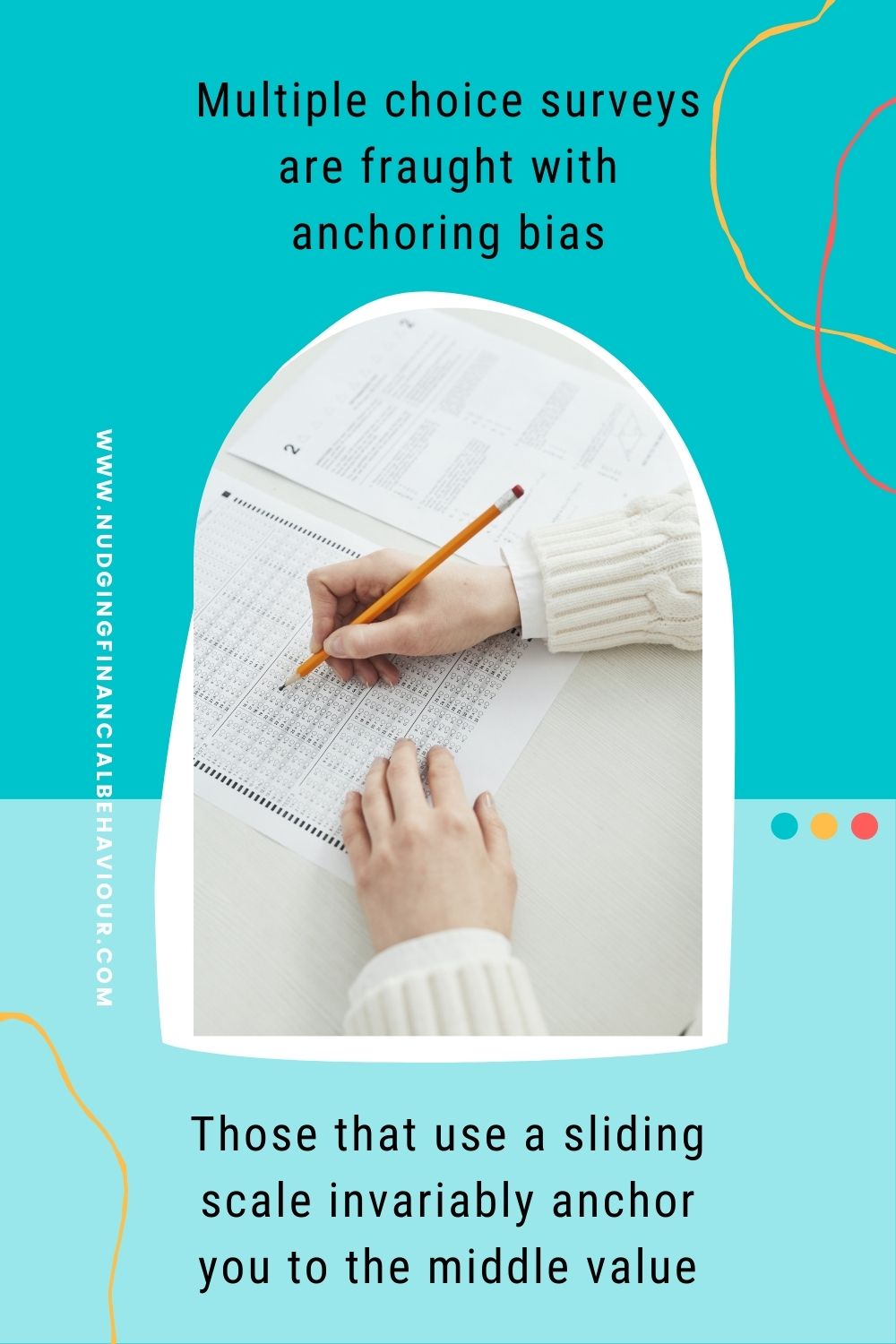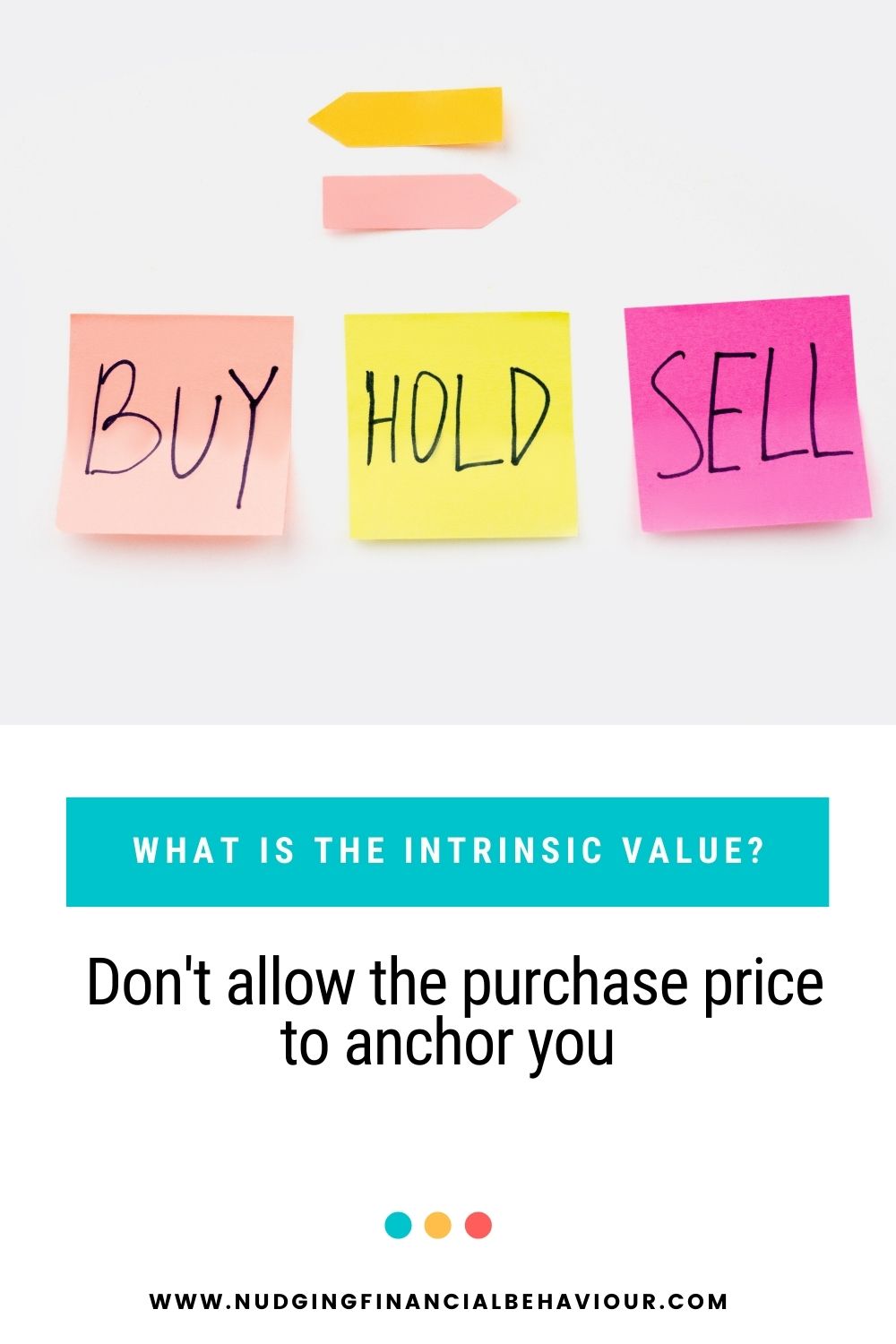Anchoring bias is a straightforward behavioural bias that causes us to focus on a certain initial value and then make decisions with reference to it. Anchoring biases are pervasive. In this post we’ll discuss a number of anchoring effect examples to identify where they’re most prevalent and thus, hopefully, help reduce some of our silliness.
We’ll be covering the following:
Consider the nautical phrase ‘anchors aweigh’. This quite simply refers to the point at which an anchor starts to take weight as it’s pulled in, which in turn means the anchors are clear of the sea bottom and, therefore, the ship is officially under way. That’s sort of what we’re aiming for.
When was Albert Einstein born? If you don’t know the answer off the top of your head and you have no access to the internet, how would you answer this question? Perhaps you know that he was somehow associated with the atomic bomb development for the US (misquoted involvement aside, we’re just interested in the timelines). So that must have been before the US dropped the bomb on Hiroshima. And you know the Pearl Harbour and Hiroshima bombings were somewhere in the early 1940’s. When you think of Einstein in all those photos at the height of his career, you don’t see a young guy, but an older scientist, perhaps someone in their 60s? So, working back 60 years before 1940, our best estimate might be 1880.
The correct answer is 1879. Pretty close, huh? How did we work it out? We found an anchor to help us – the 1940s – and worked from there to arrive at an educated guess.
Whenever we need to guess something, we do this. It would be foolish to just pick a number off the top of our heads. We start with something we know and then use that to guide us into the unknown. Whether it’s guessing the number of people in Hong Kong, or the height of the Eiffel Tower – we use anchors. There’s no other way for us to do it. The problem though, is that we also use anchors when we don’t need to.
The most well-known of anchoring effect examples is an experiment performed in 1974 by Amos Tversky and Daniel Kahneman where they asked participants: “what is the percentage of African nations in the UN?” while spinning a wheel of fortune with numbers from 1 to 100 on it. Where the wheel stopped was completely irrelevant, however, it was found that it influenced the answers given by the participants. They were asked whether their answer was higher or lower than the number shown on the wheel of fortune. Results showed that, according to the participants, the percentage of African countries in the UN was 25% for the group that witnessed the wheel of fortune stopping on the number 10, and 45% for the group that witnessed it stopping on the number 65. How can a completely irrelevant number affect our decision making?
Another equally trivial anchoring effect example was done using participants’ social security numbers as an anchor. Participants wrote down the last two digits of their social security number and then had to submit mock bids on a variety of consumer products. Unconsciously, higher bids were made by participants who wrote down higher digits. Bizarre, right? Imagine if I asked you to write down a random number and then asked you to bid on something? We now know that the number would become your reference point and your bid will be adjusted from that. How are we so easily fooled?

Multiple choice surveys are also fraught with anchoring bias examples. Those that use a sliding scale invariably anchor the respondent to the middle value. If you ask someone how often they wash their hair in a month, on a scale of 0 to 20, they’ll likely give a number somewhere in the middle. Change the scale to 0 and 30 and they’ll likely increase their answer.
This cognitive bias is pervasive and occurs in many instances, but most notably with real-estate agents, poll surveyers, car salesmen, investment brokers and supermarkets. Quite simply, by anyone who wants us to buy something. If you’re being presented with a number and then being asked to make a decision with it, be assured that you’re being tricked into a behaviour that most likely is not in your best interest.
The most well-known of anchoring effect examples is an experiment performed in 1974 by Amos Tversky and Daniel Kahneman where they asked participants: “what is the percentage of African nations in the UN?” while spinning a wheel of fortune with numbers from 1 to 100 on it. Where the wheel stopped was completely irrelevant, however, it was found that it influenced the answers given by the participants. They were asked whether their answer was higher or lower than the number shown on the wheel of fortune. Results showed that, according to the participants, the percentage of African countries in the UN was 25% for the group that witnessed the wheel of fortune stopping on the number 10, and 45% for the group that witnessed it stopping on the number 65. How can a completely irrelevant number affect our decision making?
Another equally trivial anchoring effect example was done using participants’ social security numbers as an anchor. Participants wrote down the last two digits of their social security number and then had to submit mock bids on a variety of consumer products. Unconsciously, higher bids were made by participants who wrote down higher digits. Bizarre, right? Imagine if I asked you to write down a random number and then asked you to bid on something? We now know that the number would become your reference point and your bid will be adjusted from that. How are we so easily fooled?
Multiple choice surveys are also fraught with anchoring bias examples. Those that use a sliding scale invariably anchor the respondent to the middle value. If you ask someone how often they wash their hair in a month, on a scale of 0 to 20, they’ll likely give a number somewhere in the middle. Change the scale to 0 and 30 and they’ll likely increase their answer.

This cognitive bias is pervasive and occurs in many instances, but most notably with real-estate agents, poll surveyers, car salesmen, investment brokers and supermarkets. Quite simply, by anyone who wants us to buy something. If you’re being presented with a number and then being asked to make a decision with it, be assured that you’re being tricked into a behaviour that most likely is not in your best interest.
Consider one study where students and real estate agents were asked to tour a house and value it. Before doing so, they were given a 10-page packet of information about the property, which included its listing price. The values assigned by both the experts (the real estate agents) and amateurs (the students) were influenced by the provided anchor, the listing pricing of the house. Despite the listing price being irrelevant to the value, the higher it was, the higher the value given. This shows how impactful anchors can be. Despite the presence of substantial sets of alternative information (a tour of the house) and using both experts and amateurs, the anchor came into play.

From a behavioral perspective, we also subliminally create our own anchors. Consider another example of anchoring bias in the real estate market. A potential seller might get a variety of estate agents to come value their house. It’s only natural that the seller might end up being anchored to the highest valuation they receive. When the house is on the market and offers start coming in, the seller might not accept because the offers are not at that top valuation price. Even though they might be offers at the more realistic valuation suggested by another estate agent and it’s the right time for the seller to be moving. By being anchored to another price, they miss out on that opportunity. If you want to dig even deeper into human psychology, some sellers purposely set the asking price too high because they’re not emotionally ready to move on.
Consider one study where students and real estate agents were asked to tour a house and value it. Before doing so, they were given a 10-page packet of information about the property, which included its listing price. The values assigned by both the experts (the real estate agents) and amateurs (the students) were influenced by the provided anchor, the listing pricing of the house. Despite the listing price being irrelevant to the value, the higher it was, the higher the value given. This shows how impactful anchors can be. Despite the presence of substantial sets of alternative information (a tour of the house) and using both experts and amateurs, the anchor came into play.
From a behavioral perspective, we also subliminally create our own anchors. Consider another example of anchoring bias in the real estate market. A potential seller might get a variety of estate agents to come value their house. It’s only natural that the seller might end up being anchored to the highest valuation they receive. When the house is on the market and offers start coming in, the seller might not accept because the offers are not at that top valuation price. Even though they might be offers at the more realistic valuation suggested by another estate agent and it’s the right time for the seller to be moving. By being anchored to another price, they miss out on that opportunity. If you want to dig even deeper into human psychology, some sellers purposely set the asking price too high because they’re not emotionally ready to move on.

For an investor, a typical anchor is the original purchase price. And as we already know, we are unlikely to sell below that price (see loss aversion). But what about dividends? Basing your investment decisions on share prices at least directly contributes to the movement in those prices (a self-fulfilling prophesy). But how many of us invest based on dividends and are anchored to that, when it’s something we cannot even directly affect?
Also, think about how analysts might go about valuing a company. Do they always start with fundamental analysis, or do they look at a previous valuation and adjust on that basis? Remember this when using broker recommendations.
Finally, consider how you are anchored to that initial price after you’ve bought the share. When you need to make a subsequent decision to sell or hold (or buy more), regret avoidance and the disposition effect come knocking. Also, new information is often not taken into consideration as we believe our original viewpoint is more relevant than any information that comes afterwards. This sounds like a confirmation bias example, doesn’t it? (Perhaps even herding behaviour). Can you see how anchors are linked to almost every other cognitive bias? This is why diversification and having a long-term outlook is so beneficial.

Also, think about how analysts might go about valuing a company. Do they always start with fundamental analysis, or do they look at a previous valuation and adjust on that basis? Remember this when using broker recommendations.
Finally, consider how you are anchored to that initial price after you’ve bought the share. When you need to make a subsequent decision to sell or hold (or buy more), regret avoidance and the disposition effect come knocking. Also, new information is often not taken into consideration as we believe our original viewpoint is more relevant than any information that comes afterwards. This sounds like a confirmation bias example, doesn’t it? (Perhaps even herding behaviour). Can you see how anchors are linked to almost every other cognitive bias? This is why diversification and having a long-term outlook is so beneficial.


Sometimes these anchors are merely the first piece of information that we hear. Consider a salary negotiation, whoever makes the first offer establishes a range of reasonable possibilities in each person’s minds. I’m sure you’ve had an experience of trying to sell something and starting at a price that is higher than you perhaps think is fair, with the expectation that you’ll be haggled down. You’ll then end up at a price closer to the actual value of the item.
We all grab onto anchors. The ‘recommended retail price’ printed on many products is an anchor. What we need to be mindful of is when those anchors are helping us (when we need to make an educated guess) and when they’re pushing us to make a decision.
In conditions of uncertainty, we tend to exacerbate our behavioural biases. This explains (but doesn’t necessarily excuse) why we attach an arbitrary number to something, without even realising it. Creating more anchoring effect examples.
With anchoring, we have the tendency to grab hold of irrelevant and often subliminal inputs in the face of uncertainty. Share on XSometimes these anchors are merely the first piece of information that we hear. Consider a salary negotiation, whoever makes the first offer establishes a range of reasonable possibilities in each person’s minds. I’m sure you’ve had an experience of trying to sell something and starting at a price that is higher than you perhaps think is fair, with the expectation that you’ll be haggled down. You’ll then end up at a price closer to the actual value of the item.

We all grab onto anchors. The ‘recommended retail price’ printed on many products is an anchor. What we need to be mindful of is when those anchors are helping us (when we need to make an educated guess) and when they’re pushing us to make a decision.
In conditions of uncertainty, we tend to exacerbate our behavioural biases. This explains (but doesn’t necessarily excuse) why we attach an arbitrary number to something, without even realising it. Creating more anchoring effect examples.
With anchoring, we have the tendency to grab hold of irrelevant and often subliminal inputs in the face of uncertainty. Share on XA final consideration is that of framing. Presenting the same situation in a different way using different frames, can anchor people in a certain way. This is where loss aversion creeps in again. Present a situation in terms of possible losses and people will likely take on risk to avoid those losses (risk-seeking). However, frame that same situation in terms of possible gains and we become risk-averse in trying to protect those gains. Anchors are ever-present in behavioural finance.
Whether you’re speaking to a real-estate agent, car salesman, or walking down the aisle at your local supermarket, beware of being anchored to a reference point. “Buy 4 for the price of 3!” That’s anchoring right there.
When you speak to your financial advisor, their recommendations are an anchor. And how does a company’s earnings announcement affect your assessment of their stock price? What’s important is to remember that you’re being anchored. Don’t allow your cognitive biases to influence your decision making, especially in negotiations.
We have no idea about most things and what they cost
Be careful of setting anchors with your investment returns. It’s fine to have a return goal, inflation + x%, but we must remember that we invest for the long term. If that investment return goal starts being a benchmark that you anchor all short term returns against you run into the risk of responding impulsively.
Anchoring is prevalent in everyday decision-making. What we should be mindful of is the need to differentiate between price and value. Forget about the ‘deal’ or what’s being punted. Make decisions based on the intrinsic value of the transaction. As we’ve seen with the Einstein example, some real knowledge can eliminate the uncertainty and ultimately the problem.
Want to pin this post for later?
[apsp_save_button type=’one-image’ shape=’rectangle’ size=’large’ save_url=’https://nudgingfinancialbehaviour.com/loss-aversion-vs-risk-aversion/’ save_image=’https://nudgingfinancialbehaviour.com/loss-aversion-vs-risk-aversion/’ image_description=’Anchoring bias is a straightforward behavioural bias that causes us to focus on a certain initial value and then make decisions with reference to it. Let’s look at some anchoring effect examples.’]
Let us know in the comments below.
Let us know in the comments below.
[apsp-follow-button name=’nudgingfinancialbehaviour’ button_label=’Follow on Pinterest’]
I am passionate about helping people understand their behaviour with money and gently nudging them to spend less and save more. I have several academic journal publications on investor behaviour, financial literacy and personal finance, and perfectly understand the biases that influence how we manage our money. This blog is where I break down those ideas and share my thinking. I’ll try to cover relevant topics that my readers bring to my attention. Please read, share, and comment. That’s how we spread knowledge and help both ourselves and others to become in control of our financial situations.

Dr Gizelle Willows
PhD and NRF-rating in Behavioural Finance
Receive gentle nudges from us:
[user_registration_form id=”8641″]
“Essentially, all models are wrong, but some are useful.” – George E.P. Box

The blog is written well